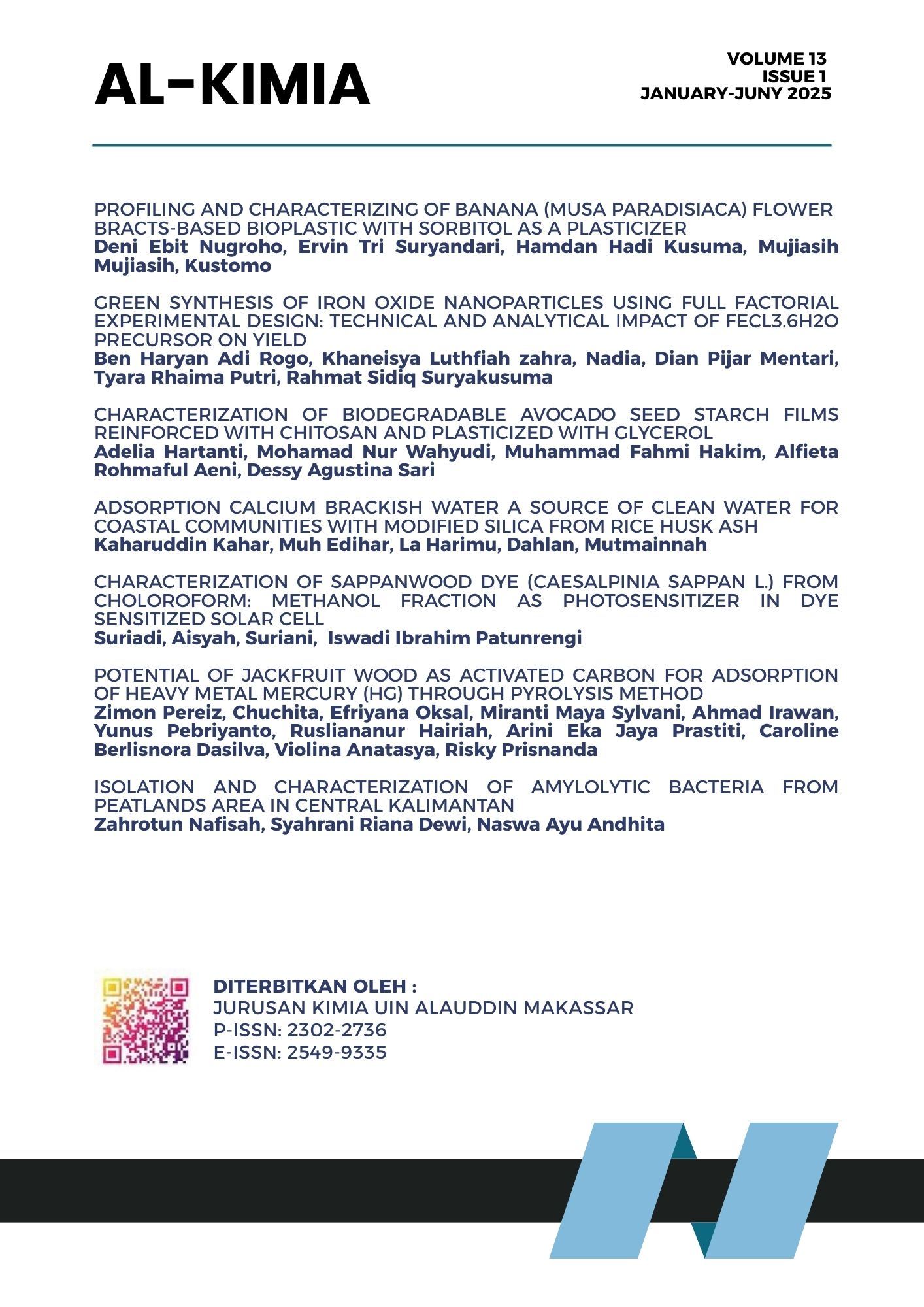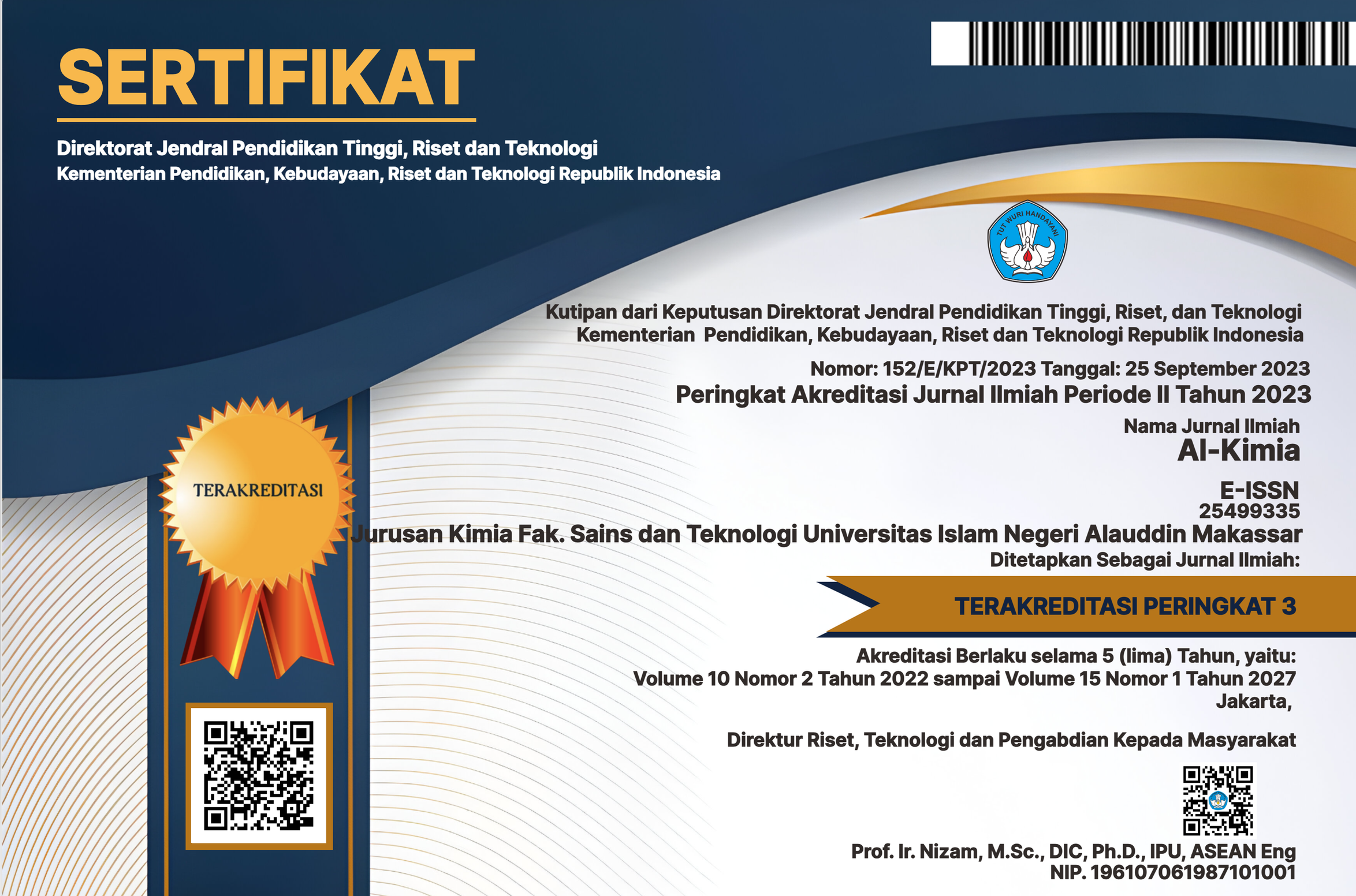The Potential of Jackfruit Wood as Activated Carbon for Adsorption of Heavy Metal Mercury (Hg) through Pyrolysis Method
Keywords:
jackfruit wood, mercury, pyrolysis, acid activation.Abstract
Water pollution caused by heavy metal mercury is a serious problem today. This study aims to utilise jackfruit wood waste as a natural adsorbent in overcoming the problem of water pollution due to heavy metal mercury. The methods in this research include jackfruit wood preparation, hydrochar synthesis through pyrolysis, hydrochar activation, wastewater preparation, batch adsorbent optimum conditions, and dynamic adsorption process (Fixed-Bed Column). The results showed that the optimum adsorption condition was reached at 0.4 M HCl concentration, pH 3 and 80minutes contact time. The study also showed that the adsorption kinetics followed a second-order pseudo model with a rate constant of 1.712 x 10-2 g/mg.min. The research data also showed conformity with the Langmuir isotherm model, with an adsorption capacity of 63.036 mg/g. The results of this study prove that jackfruit wood waste is effectively used as raw material for making activated carbon for wastewater treatment applications in removing heavy metal mercury.
Downloads
References
Afifudin, A. F. M., Wulandari, A., & Irawanto, R. (2024). Pencemaran Logam Berat di Air, Sedimen, dan Organisme pada Beberapa Sungai di Pulau Jawa, Indonesia: Tinjauan Literatur. Environmental Pollution Journal, 4(1), 959–971. https://doi.org/10.58954/epj.v4i1.183
Ayuchecaria, N., Oksal, E., Sri Martani, N., Kartika Komara, N., & Pereiz, Z. (2024). Skrining Fitokimia dan Uji Antibakteri Ekstrak Etanol Daun Hanjuang Merah (Cordyline fruticose) terhadap Bakteri Staphylococcus epidermidis. Jurnal Insan Farmasi Indonesia, 7(1), 86–94. https://doi.org/10.36387/jifi.v7i1.1683
Darajat, Z., Septiani, M., Teknik Kimia, J., Negeri Ujung Pandang, P., Studi Teknik Kimia, P., & Tinggi Teknologi Industri Bontang, S. (2023). Pengaruh Waktu Aktivasi Terhadap Karakterisasi Arang Aktif Tongkol Jagung dengan Menggunakan Aktivator H2SO4. Jurnal Juara, 3(1), 2798–3315.
Ekaputra Bernadus, G., Polii, B., & Alfred Rorong, J. (2021). Dampak Merkuri Terhadap Lingkungan Perairan Sekitar Lokasi Pertambangan Di Kecamatan Loloda Kabupaten Halmahera Barat Provinsi Maluku Utara. Jurnal Transdisiplin Pertanian, 5, 599–610.
Irawan, C., Ardiansyah, A., & Hanan, N. (2014). Potensi Hayati Serat Purun Tikus (Eleocharis Dulcis) Dalam Proses Adsorpsi Kandungan Logam Berat Merkuri (Hg), TSS dan COD Pada Limbah Cair Pertambangan Emas. Konversi, 3(1), 17. https://doi.org/10.20527/k.v3i1.133
Kamarati, K. F. A., Marlon, I. A., & Sumaryono, M. (2018). Kandungan Logam Berat Besi ( Fe ), Timbal ( Pb ) dan Mangan ( Mn ) pada Air Sungai Santan Heavy Metal Content Iron ( Fe ), Lead ( Pb ) and Manganese ( Mn ) in The Water of The Santan River. JURNAL Penelitian Ekosistem Dipterokarpa, 4(1), 49–56.
Lingkungan, J. B., Neneng, L., Ngazizah, F. N., Oksal, E., & Pereiz, Z. (2025). BioLink The Effect of Organic Biofertilizer from Bsf Larvae ( Hermetia illucens ) And Local Microorganism on The Growth of Caisim Mustard Plants. 11(2), 117–126. https://doi.org/10.31289/biolink.v11i2.13289
Mutiara, T., Rofiki, I., & Al Ghifari, M. A. D. (2018). Bio adsorbent from modified jackfruit wood sawdust for removal of lead ions. Materials Science Forum, 934 MSF, 159–164. https://doi.org/10.4028/www.scientific.net/MSF.934.159
Nafisah, Z., Rahman, S., Pereiz, Z., & Ratna Kumalasari, M. (2023). Pemberdayaan Masyarakat Melalui Edukasi Pemanfaatan Limbah Cair Tempe Menjadi Biogas di Desa Habaring Hurung. Journal of Approriate Technology for Community Services, 5(1), 24–32. https://doi.org/10.20885/jattec.vol5.iss1.art4
Oksal, E., Fatah, A. H., Pereiz, Z., Fauzi, M. Z. L., Komara, N. K., & Pangestika, I. (2025). Pelatihan Pembuatan Lilin Aromaterapi Dalam Peningkatan Kreativitas Siswa Sman 1 Kasongan. 9(2), 1575–1583.
Palallo, F., & Oskar, I. (2023). Pengaruh Ukuran Arang Aktif Sebagai Filter TerhadapReduksi Hidrogen Sulfida Pada Biogas. Jurnal Nasional Teknik Mesin Cycloid, 1(1), 1–10.
Pereiz, Z. (2024). Analysis of Hexadecyltrimethoxysilane Nanosol Hybrids through optimization of Silica Nanosol Concentration and determining fabric types on Hydrophobicity Analysis of Silica-Hexadecyltrimethoxysilane Nanosol Hybrids through optimization of Silica Nanosol C. 15(1), 195–210.
Pereiz, Z., Chuchita, C., Kumalasari, M. R., & Nafisah, Z. (2023). Analisis Aspartam Dengan Metode Spektrofotometri Uv-Visible serta Optimasi Konsentrasi Ninhidrin dan Aplikasinya Untuk Penentuan Kandungan Dalam Minuman Energi Zimon. Jurnal Indonesia Sosial Teknologi, 4(4), 508–525.
Pereiz, Z., Nafisah, Z., Rahman, S., Ratna Kumalasari, M., Studi Kimia, P., Palangka Raya, U., & Studi Farmasi, P. (2023). Mengurangi Emisi Gas (Zimon Pereiz dkk.) | 119 Nanggroe. Jurnal Pengabdian Cendikia, 2(6), 119–126. https://doi.org/10.5281/zenodo.8393970
Pereiz, Z., Oksal, E., Chuchita, C., Sylvani, M. M., & Kartika, N. (2024). Permen Buah Karamunting : Inovasi Pangan Lokal untuk Penanggulangan Stunting pada Anak ( Karamunting Fruit Candy : Local Food Innovation to Reduce Stunting in Children ). 4(4), 571–577.
Pereiz, Z., Oksal, E., Sylvani, M. M., & Irawan, A. (2025). The Potential of Ironwood as an Activated Carbon Adsorbent for Heavy Metal Mercury ( Hg ) using the Pyrolysis Method Potensi Kayu Ulin Sebagai Adsorben Karbon Aktif Untuk Logam Berat Merkuri ( Hg ) Menggunakan Metode Pirolisis. 19(1), 25–36.
Pereiz, Z., Pebriyanto, Y., Naulita Turnip, O., Maya Sylvani, M., Karelius, K., Putra Ramdhani, E., Chuchita, C., Agnestisia, R., Horale Pasaribu, M., & Prasetya Toepak, E. (2023). Synthesis of MIL-100(Fe)@Fe3O4 from Magnetic Zircon Mining Waste Modified by CTAB for Naphthol Dye in Water Removal. BIO Web of Conferences, 79. https://doi.org/10.1051/bioconf/20237912005
Prabarini, N., & Okayadnya, D. (2014). Penyisihan Logam Besi (Fe) Pada Air Sumur Dengan Karbon Aktif Dari Tempurung Kemiri. Envirotek : Jurnal Ilmiah Teknik Lingkungan, 5(2), 33–41.
Rahmadewi, R., Efelina, V., & Purwanti, E. (2019). Sintesis Nanopartikel Mrgo Untuk Aplikasi Adsorpsi Logam Berat Pada Limbah Cair. JiTEKH, 7(2), 29–35.
Ratna Kumalasari, M., Pereiz, Z., & Chuchita, C. (2023). Pengaruh pH Agen Pereduksi Serin Terhadap Sintesis Nanopartikel Emas. COMSERVA Indonesian Jurnal of Community Services and Development, 2(12), 2912–2918. https://doi.org/10.59141/comserva.v2i12.727
Rini, D. S., Swastana, I. W., & Diansyah, A. (2019). Variasi radial sifat kayu nangka (Artocarphus heterophyllus) yang berasal dari Desa Sesaot Kabupaten Lombok Barat. Jurnal Sangkareang Mataram, 5(2), 66–71.
Rizkyka, Y., & Riyanti, A. (2024). Manajemen dan Pariwisata Pemanfaatan Biji Nangka Dan Biji Kluwih Sebagai Pendukung Produk Pound Cake (Utilization Of Jackfruit Seed And Kluwih Seed As Product Supporting For Pound Cake). 3(1), 73–98.
Sa’diyah, K., Suharti, P. H., Hendrawati, N., Pratamasari, F. A., & Rahayu, O. M. (2021). Pemanfaatan Serbuk Gergaji Kayu sebagai Karbon Aktif melalui Proses Pirolisis dan Aktivasi Kimia. CHEESA: Chemical Engineering Research Articles, 4(2), 91. https://doi.org/10.25273/cheesa.v4i2.8589.91-99
Segah, H., Oksal, E., Pereiz, Z., & Supriyati, W. (2024). Pengujian Kualitas Arang Dari Serbuk Ulin Dengan 2 Metode Pengeringan. 42(2).
Widianti, N. N., Jenius, V. A. S., Hidayat, N. A. R., & Sukma, W. M. (2024). Pengelolaan limbah, faktor, dan penyebab paparan logam berat merkuri pada lingkungan. Jurnal Sains Student Research, 2(2), 119.
Yudo, S. (2018). Kondisi Pencemaran Logam Berat Di Perairan Sungai Dki Jakarta. Jurnal Air Indonesia, 2(1), 1–15. https://doi.org/10.29122/jai.v2i1.2275
Downloads
Published
Versions
- 2025-07-27 (2)
- 2025-06-29 (1)
How to Cite
Issue
Section
License
Authors who publish with this journal agree to the following terms:
1) Authors retain copyright and grant the journal right of first publication with the work simultaneously licensed under a Creative Commons Attribution License that allows others to share the work with an acknowledgement of the work's authorship and initial publication in this journal.
2) Authors are able to enter into separate, additional contractual arrangements for the non-exclusive distribution of the journal's published version of the work (e.g., post it to an institutional repository or publish it in a book), with an acknowledgement of its initial publication in this journal.
3)Authors are permitted and encouraged to post their work online (e.g., in institutional repositories or on their website) prior to and during the submission process, as it can lead to productive exchanges, as well as earlier and greater citation of published work (See The Effect of Open Access).



